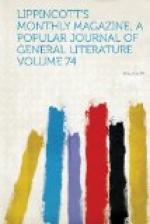It is a coincidence merely, but nearly all the great libraries of the city are grouped within a block or two of Astor Place, making that short thoroughfare the scholarly centre of the town. In its immediate vicinity, on the corner of Second Avenue and Eleventh Street, stands the fire-proof building of the New York Historical Society, whose library and collection of paintings and relics form one of the features of the city. This Society dates back to the year 1804, when Egbert Benson, De Witt Clinton, Rev. William Linn, Rev. Samuel Miller, Rev. John N. Abeel, Rev. John M. Mason, Dr. David Hosack, Anthony Bleecker, Samuel Bayard, Peter G. Stuyvesant, and John Pintard, met by appointment at the City Hall and agreed to form a society “the principal design of which should be to collect and preserve whatever might relate to the natural, civil, or ecclesiastical history of the United States in general and of the State of New York in particular.” Active measures were at once taken for the formation of a library and museum, special committees being appointed for the purpose. The range of the collection embraced books, manuscripts, statistics, newspapers, pictures, antiquities, medals, coins, and specimens in natural history. The Society made the usual number of removals before being finally established as a householder. From 1804 to 1809 it met in the old City Hall, from 1809 to 1816 in the Government House, from 1816 to 1832 in the New York Institution, from 1832 to 1837 in Remsen’s Building, Broadway, from 1837 to 1841 in the Stuyvesant Institute, from 1841 to 1857 in the New York University, and at length, after surmounting many pecuniary obstacles, celebrated its fifty-third anniversary by taking possession of its present structure. Meantime, the efforts of the library committees had resulted in a collection of Americana of exceeding interest and value, the nucleus of the present library. In its one specialty this library is believed to be unrivalled. The Society has issued some twenty-four volumes of its own publications, in addition to numerous essays and addresses. Besides these, its library contains some seventy-three thousand volumes of printed works, chiefly Americana, many of them relating to the Indians and obscure early colonial history. Eight hundred and eleven genealogies of American families—the fountain-head of the national history—are a feature of the collection. The library also possesses one of the best sets of Congressional documents extant, also complete sets of State and city documents. There are four thousand volumes of newspapers, beginning with the first journal published in America,—the “Boston News-Letter” of 1704,—and comprising a complete record to the present day. There are also tons of pamphlets and “broadsides,” and several hundred copies of the inflammatory hand-bills posted on the trees and fences of New York during the Revolution. The library is also rich in old family letters and documents containing much curious and interesting history. The Society is very conservative in its ways,—more so than most institutions of the kind. Theoretically, its stores of information can be drawn on by members only, but, as a general thing, properly accredited scholars, non-residents, have little difficulty in gaining access to them, provided the material sought is not elsewhere accessible.




